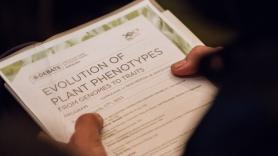1. Plants, born to change
Since the advent of agriculture 10,000 years ago, we’ve transformed some species of plants and animals to such an extent that they would now be unable to survive in nature. “We feed ourselves with species invented by human beings, which are the fruit of genetic modifications, like corn,” explains Josep Casacuberta, coordinator of the plant and animal genomics program at the Center for Research in Agricultural Genomics (CRAG) and scientific leader of this B·Debate.
The ability of living beings to adapt to their environment and, thus to survive depends in large part on their ability to evolve. In plants, there are two main mechanisms that allow for change: polyploidy andtransposons.
Polyploidy, or adding chromosomes, leads to a mosaic of new combinations. Bringing together and regulating so much new information isn’t easy, which leads plants to a stabilization process. Kirsten Bomblies, professor at Harvard University, researches the mechanisms that make this possible.
“We’ve identified several genes that seem to be essential to this process, and many of them are related to meiosis: the process of separating chromosomes that allows sex cells to form,” explains Bomblies. During meiosis, information is exchanged between chromosomes. This researcher’s hypothesis is that plants, once stabilized, limit this exchange, thus compensating for the excess of information. “If confirmed, this theory could have important repercussions on human health,” believes Bomblies. Human beings generate variations in different ways than plants do, but the polyploidy process can generally be seen in cancer. So, understanding the mechanisms that can diminish that imbalance could lead to applications in oncology research.
Transposons —the small mobile fragments of “travelling” DNA— are also the focus of current research in agrigenomics. Some of these are more at risk of becoming activated, moving around the genome and causing changes. Marie Mirouze, researcher at the Montpellier Institute for Development Research, uses a technique to identify these elements that are “ready to jump”, which as a whole have come to be called the “mobilome”. To do so, she scans DNA circles, or closed pathways the cell provokes in the transposons to prevent them from returning to the DNA once their copies have left it. One small error in that closing could allow them to return and transfer to the genome, provoking unpredictable changes.
The genetic shuffle
Polyploidy is the adding of chromosomes, whether by multiplying those a plant already has or merging its chromosomes with those of another species. Transposons are a very different mechanism: they are mobile elements, small fragments of DNA that can move around, travel to other parts of the chromosome or to other chromosomes, and can create new traits on these excursions. They are, for example, responsible for the fact that some species of corn have different colored kernels: when a transposon controlling the color gene moves, the way it manifests externally also changes. And even though only some of them are active, they can comprise up to 80% of a plant’s DNA.
In general, both mechanisms act like shuffling a deck of cards: polyploidy allows the plant to play with twice (or three or many times) as many cards; transposons allow it to change the order of the deck, trying out different combinations like a game of poker or as if searching for run.



